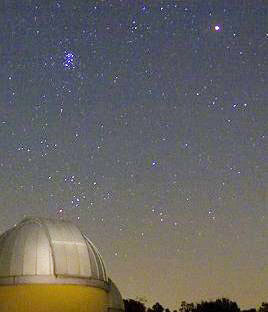|
The red planet, already intense, is about
to get much brighter.
by Dr Tony Phillips
Step outside tonight
around midnight and look east. About halfway up the sky you'll see
the planet Mars. It looks like an intense red star, the brightest
light in the midnight sky other than the Moon.
Here's the amazing
part: Between now and the end of October, Mars, already so bright,
will double in brightness again. Imagine that.
Mars is getting brighter
for the simple reason that it's getting closer. Earth and Mars have
been converging for months and on Oct. 30th 2005 at 0319 Universal
Time, the two worlds will be just 69 million kilometers apart -
the closest approach of Mars and Earth for the next 13 years.
The timing is practically
perfect for Halloween. Millions of kids and their parents will be
outdoors after dark trick-or-treating on Oct 31st. Mars will rise
at sundown that night, bright enough to be seen even from urban-lit
cities. Furthermore, purists insist, Mars isn't really red, it’s
pumpkin-colored. Could it get any better?

Photographed on Sept. 8th by Stan Richard
in rural Jasper County, Iowa.
Mars
and the Pleiades
|
Oh, yes.
The timing is practically
perfect for Halloween. Millions of kids and their parents will be
outdoors after dark trick-or-treating on Oct 31st. Mars will rise
at sundown that night, bright enough to be seen even from urban-lit
cities. Furthermore, purists insist, Mars isn't really red, it’s
pumpkin-colored. Could it get any better?
Oh, yes.
In 2003, the last time
Earth and Mars converged, Mars was bright, but it was also low,
never climbing more than about 34o above the horizon as seen from
North America and Europe. In 2005, on the other hand, Mars is going
be much higher in the sky: about 66o.
This is good news for
people with backyard telescopes, because planets high in the sky
look crisp and clear. Lower down, near the horizon where the air
is thick, they become murky and indistinct. Mars in 2005 is nicely
placed for detailed, high-magnification viewing.

Credit: Alan Friedman of Buffalo, NY.
Mars,
the view through a 10" telescope on Sept. 18, 2005.
North is up.
|
Already backyard astronomers
are seeing some extraordinary things—like the "purple
haze." Winter is beginning at the Martian north pole, and icy-blue
clouds are gathering there. The vast cloud bank is easily seen through
10-inch and larger telescopes, purple enough to remind some observers
of Jimi Hendrix. The view will only improve as Oct. 30th approaches.
NASA is taking advantage
of the close encounter to send a robot-ship to Mars. Named Mars
Reconnaissance Orbiter, it left Earth in August carrying, among
other things, the biggest camera ever sent to another planet. The
High Resolution Imaging Science Experiment, or "HiRISE",
weighs 145 lbs (on Earth); its primary optical mirror is a half-meter
wide; and it can take pictures with 1200 megapixels of digital resolution.
From Mars orbit, this monster camera can see things as small as
a dishwasher. It's due to arrive in March 2006 to begin mapping
Mars in exquisite detail for explorers of the future.
By the time the orbiter
reaches Mars it will have traveled more than 400 million km. You
only need to go as far as your backyard. Look up, and be amazed.
|
